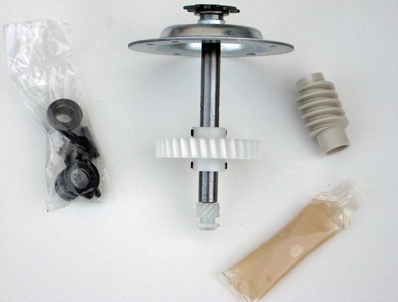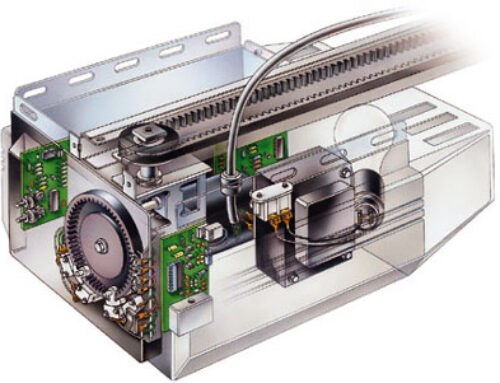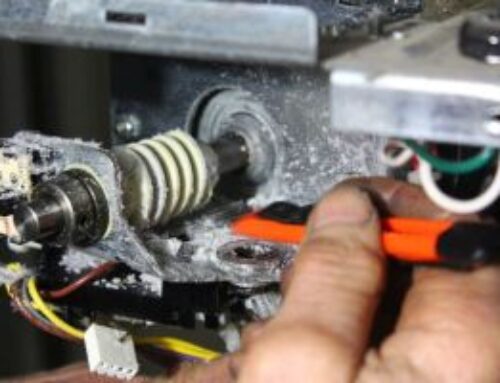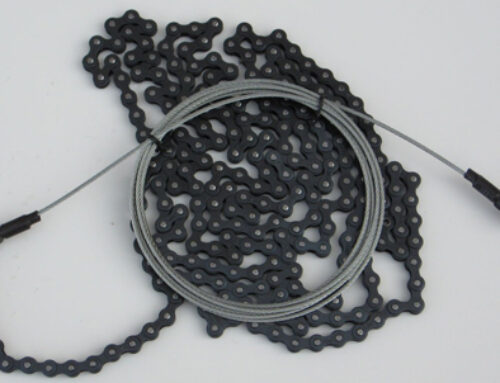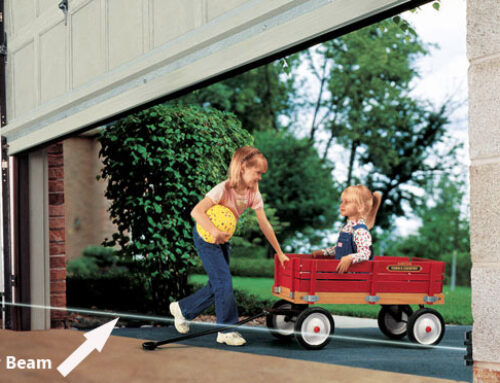In most Chamberlain, Lift master, and Sears’s openers a motor turns the worm gear and drive shaft inside the opener, which rotates the sprocket attached to the top of the drive shaft. This turns the chain and moves the door.
The most common issue that occurs is when the ridges in the gear wear out because the gear lubrication has evaporated. As a result of the worn gear, the sprocket cannot turn the chain and the door will not open nor close
If your garage doors springs are intact chances are you garage door openers main drive gear has failed. You can easily inspect your drive gears by unplugging your garage door opener and removing the metal cover. The main drive gear is made of a white plastic that typically is the weak link in the opener. Many things can cause this gear to fail. Some causes of wear are:
- Garage door out of balance (Springs broke or in need of adjustment)
- Chain to tight a
- Old age
- Excessive use or high cycle
- Factory defect or lack of grease at time of manufacture
Replacing the large white gear is a low cost, quick and easy do it yourself repair as long as you have a few simple hand tools and follow the safety precautions. These gears can be purchased online in a variety of levels of components.
This garage door opener DIY repair guide gives step-by-step instructions for replacing the drive and worm gears on a chain-drive garage door opener. The worm gear attaches to the motor shaft and meshes with the drive gear to spin the sprocket at the top of the motor unit. The sprocket drives the chain that connects to the trolley and moves the trolley along the rail to raise and lower the garage door. The garage door won’t move if the drive and worm gears break. If your drive and worm gears break, replace them using a manufacturer-approved replacement part.
Tools Required
- Step ladder
- Allen wrench set
- Hammer
- Punch set
- Emery paper
- Work table
- Socket wrench set
- Slot screwdriver
- Work gloves
Parts Required: Drive and worm gear kit (includes the grease). The following steps will guide you into replacing the drive and worm gears on a chain. Before you begin make sure you wear work gloves to protect your hands.
Step 1: Disconnect power
- Use a step ladder to access the garage door opener’s power cord and motor unit.
- Unplug the garage door opener.
Step 2: Take the garage door opener down
Tip: You may want to have a helper assist you when taking the garage door opener down.
- Position a work table near the area under your motor unit to hold the garage door opener during the repair.
- Pull the emergency release rope to release the trolley from the garage door.
- Shut the garage door if it’s not already closed.
- Remove the fastener ring from the straight door arm connected to the outer trolley.
- Pull out the clevis pin while supporting the straight arm to disconnect the garage door from the outer trolley.
- Lower the straight and curved arms down and rest them against the garage door.
- Open the light cover to access the wall control and safety sensor wires connected to the motor unit.
- Take a digital photo of the wall control and safety sensor wires connected to the motor unit. You’ll refer to the photo later when reconnecting the wires.
- Disconnect the wall control and safety sensor wires from the motor unit.
- Close the light cover.
- Remove the nuts, bolts, and lock washers that secure the motor unit to the ceiling bracket. Support the motor unit with one hand as you remove the last bolt from the ceiling bracket.
- Carefully lower the motor unit down and rest it securely on top of the step ladder.
- Climb down the step ladder, lower the motor unit down and rest it on your work table.
- Move your step ladder by the garage door so you can remove the rail from the header bracket.
- Remove the fastener ring from the header bracket clevis pin.
- Pull the clevis pin out of the rail and header bracket while supporting the rail with one hand.
- Lower the rail and rest it on a rung of the step ladder so the rail is level with the motor unit on your work table.
Tip: To avoid scratching a decorative garage door, remove the nuts, bolts and washers from the curved arm and carefully rest the curved arm against the door when disconnecting the garage door from the outer trolley.
Step 3: Remove the chain and cable assembly
- Using a felt-tip marker, mark a link of chain and the sprocket tooth that meshes with it for when you reinstall the chain after replacing the drive and worm gears.
- Slide the outer trolley away from the inner trolley.
- Remove the outer nut and lock washer from the trolley threaded shaft and pull the threaded shaft out of the trolley.
- Pull the chain off the motor unit sprocket and out of the chain spreader.
- Lay the chain out on the garage floor while you complete the repair.
Step 4: Remove the gear and sprocket assembly
- Remove the light covers and light bulbs from the motor unit.
- Remove the screws from the chain spreader and pull the chain spreader off the motor unit.
- Remove the screws from the motor unit cover and pull the motor unit cover off.
- Remove the plastic helical gear retainer and pull the helical gear off.
- Release the limit switch locking tabs by squeezing the sides just below the motor bracket near the helical gear.
- Move the limit switch aside and let it hang by its wires.
- Remove the gear and sprocket assembly mounting screws.
- Pull the gear and sprocket assembly out
Step 5: Remove the motor
- Remove the main bearing from the motor plate.
- Unplug the RPM sensor wire harness.
- Remove the interrupter cup from the motor shaft.
- Remove the motor mounting nuts from the front of the motor plate.
- Pull the motor out of the motor plate and set it beside the motor unit.
- Pry off the motor shaft bearing retaining clip and pull the motor shaft bearing out of the motor plate.
Tip: On some models, you’ll need to loosen the set screws on the set collar and remove the set collar from the motor shaft, then remove the washer cap, spring washer, flat washer and bushing from the motor shaft before removing the mounting nuts from the motor plate and pulling the motor out.
Step 6: Replace the worm gear
- Use a punch and hammer to drive the front roll pin out of the motor shaft.
- Pull the worm gear off the motor shaft and clean the motor shaft using fine grit emery paper.
- Remove the O-ring, C-ring and spacer from the motor shaft.
- Install the new O-ring, C-ring and spacer on the motor shaft.
- Lubricate the worm gear with grease, and then slide the new worm gear onto the motor shaft, engaging the rear worm gear notches on the roll pin.
- Reinstall the front roll pin.
Tip: Some motors have the roll pin behind the worm gear on the shaft so you pull the worm gear straight off.
Step 7: Reinstall the motor
- Install the new motor shaft bearing into the motor plate and reinstall its mounting clip, using socket to push the mounting clip against the motor plate.
- Push the motor into the motor plate and reinstall the motor mounting nuts.
- Reinstall the interrupter cup on the motor shaft.
- Apply grease to lubricate the new main bearing and install it in the motor plate.
- Reconnect the RPM sensor wire harness.
Tip: For motors with a set collar, push the new bushing onto the motor shaft and slide it against the motor plate, engaging the notch on the bushing in the slot on the motor plate. Install the new flat washer, spring washer and washer cap on the motor shaft. Slide the new set collar against the washer cap on the motor shaft. Hold the set collar stationary and push the motor shaft through the set collar from the back of the motor to eliminate shaft play, and then tighten the set screws.
Step 8: Replace the drive gear
- Use a punch and hammer to drive the roll pin out of the drive shaft.
- Pull the drive gear off the drive shaft.
- Slide the new drive gear onto the drive shaft and line up the mounting hole in the drive gear with the hole in the drive shaft.
- Insert the new roll pin through the gear and drive shaft. Drive the roll pin into place using the punch and hammer.
- Lubricate the new drive gear with grease.
Step 9: Reinstall the gear and sprocket assembly
- Insert the gear and sprocket assembly into the motor unit and install the mounting screws.
- Apply grease to the helical gear.
- Push the helical gear onto the gear and sprocket assembly shaft and secure it with the retaining clip.
Step 10: Reinstall the limit switch and motor unit cover
- Position the limit switch on the motor bracket and snap the limit switch into place, engaging the limit switch drive gear with the helical gear.
- Reinstall the motor unit cover and secure it with the mounting screws.
- Reinstall the light bulbs and light bulb covers.
- Reinstall the chain spreader, securing it with the mounting screws.
Step 11: Reinstall the chain
- Making sure not to twist the chain, thread it through the chain spreader and around the motor unit sprocket, matching the marked chain link to the marked tooth on the motor sprocket.
- Thread the inner nut up to the top of the trolley threaded shaft and reinstall the inner lock washer on the threaded shaft.
- Insert the trolley threaded shaft into the trolley hole and reinstall the outer nut and lock washer.
- Hand-tighten the outer nut.
Tip: Have a helper push the inner trolley toward the threaded trolley shaft to apply more tension to the chain and cable, making it easier to thread the outer nut onto the trolley shaft.
Step 12: Tighten the chain
- Adjust the outer nut to position the trolley threaded shaft so the chain hangs about 1/4-inch above the base of the rail at its midpoint.
- Tighten the inner nut against the trolley to secure the trolley threaded shaft.
Step 13: Reinstall the garage door opener
- Reconnect the rail end to the header bracket using the clevis pin and fastener ring
- Position your step ladder under the motor unit ceiling bracket and carefully set the motor unit on top of the step ladder.
- Climb the step ladder and reinstall the motor unit to the ceiling bracket using the nuts, bolts and lock washers.
- Open the light cover to access the wall control and safety sensor terminals on the motor unit.
- Using your digital photo for reference, reconnect the wall control and safety sensor wires to the motor unit.
- Close the light cover.
- Reconnect the straight door arm to the outer trolley using the clevis pin and fastener ring.
- Re-engage the trolley.
Tip: Reconnect the curved door arm to the straight door arm using the bolts, lock washers and nut if you disconnected the curved arm from the straight arm when freeing the garage door from the outer trolley.
Step 14: Reconnect electrical power
- Plug in the garage door opener.
Step 15: Adjust the travel limits
- Run the garage door opener through a complete travel cycle to check upper and lower travel limit.
- If the garage door doesn’t close completely, adjust the down travel and cycle the door open and closed to test the adjustment. Continue to adjust the down travel until the door closes completely.
- If the door doesn’t open completely, adjust the up travel in the same manner.
Tip: Repeated operation of the garage door opener during travel limit adjustment may cause the motor to overheat and shut off. Wait 15 minutes to allow the motor to cool and then continue adjustments.
Warning:
Undertaking repairs or maintenance to appliances or power points can be hazardous. Should you choose to undertake repairs or maintenance you are assuming the risk of injury to you as a person and/or property. In an effort to reduce the risk, it’s advisable to use the proper tools and the safety equipment that are noted in the applicable guide. One must also make sure that they follow all the instructions. Do not proceed to any step until you are confident enough that you have clearly understood all the necessary steps that need to be followed in the repair or maintenance process. Some repairs and maintenance procedures should be performed by qualified technicians.
When ordering the full gear kits that include the sprockets, please make sure that you know if your garage door opener is a chain or belt drive as there are differnet part numbers. If you just want just the gear (such as the 41A2817-CR) then the main drive gear will be the same.
41A2817-CR Gear and grease only. Works with all chain and belt models from 1984 to present LiftMaster, Sears Craftsman and Chamberlain openers using a large white gear that is 2 3/4″ x 1/2″ wide, with a 1/2″ bore.
41A2817 this kit includes the gear and grease as described above and in addition includes worm gears, replacement bushings, pins and lubricant and easy to follow installation instructions. 41A2817 Works with all chain and belt drive models from 1984 to present Liftmaster, Sears, Craftsman and Chamberlain openers using a large white gear that is 2 3/4″ x 1/2″ wide, with a 1/2″ bore.
41C4220A this kit includes all of the components above in the and includes the drive shaft and sprocket also. I recommend this kit if you do not have the 5/32” punch as mentioned in our tools requires section. It is cheaper to buy this kit than it would be to run out and buy the punch needed to remove the roll pins to replace the gear only. The main drive gears comes already installed on the shaft (very convenient) This repair kit is FOR CHAIN DRIVE MODELS ONLY. If you have a belt drive model see part number 41A4885-2 or 41A4885-5 below.
41A4885-2 use this kit if you wish to replace the complete drive shaft and belt pulley assembly on belt drive garage door openers used between 1984 and 2001. For newer models from 2002 to present see part number 41A4885-5 below
41A4885-5 use this kit if you wish to replace the complete drive shaft and belt pulley assembly on belt drive garage door openers used between 2002 to present.

